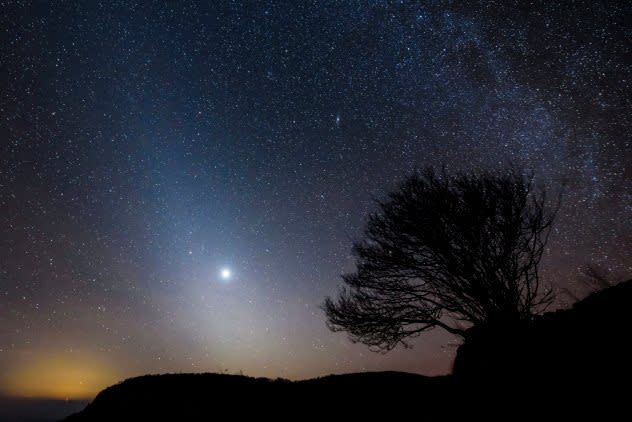April boasts 1st major meteor shower in months, plus these other astronomical happenings
As the old poem goes, April showers bring May flowers, but April will also bring a medley of astronomical events, including the first meteor shower in nearly four months.
The milder spring weather will entice more people to spend some time under the stars compared to the colder nights of winter, but spring storms could obscure the sky, potentially spoiling some of the events that can only be seen on one specific night.
April also marks the three years until one of the biggest astronomical events in the U.S. this decade.
Here are the top three astronomy events to look for in April:
1. Pyramid of light after sunset
When: Early April
The weeks surrounding the equinox bring an opportunity to spot a phenomenon that is only visible in the night sky two times a year, and with the March equinox in the rearview mirror, time is running out to see it until it appears again around the September equinox.
A pyramid-shaped glow known as the zodiacal light should be visible during the first nights of April for those with a sharp eye and located far away from light-polluted cities. In March and early April, it can be seen in the western sky after sunset in the Northern Hemisphere and in the eastern sky before sunrise in the Southern Hemisphere.
 |
The Zodiacal light, left, Venus, and the Milky Way, right, appear near the top of the Three-Stone Hill on the Bukk Plateau, near Felsotarkany, 85 miles northeast of Budapest, Hungary, Friday, Feb. 17, 2017. (Peter Komka/MTI via AP) |
The dim glow in the sky is caused by light from the sun reflecting off of dust scattered throughout the solar system. It can be very difficult to spot, so being in a dark area far away from light pollution is key in order to witness the phenomenon.
2. Lyrid meteor shower
When: April 21-22
For the first time since early January, a meteor shower will grace the night sky for the perfect outdoor event to kick off a day focused on the environment.
The Lyrid meteor shower is set to peak on the night of April 21 into the early hours of April 22 and is sometimes called the "Earth Day meteor shower" since it spills into the opening hours of the annual event geared at ways to help protect the planet.
CLICK HERE FOR THE FREE ACCUWEATHER APP
Onlookers could count between 15 and 20 meteors per hour during the second half of the night after the moon has set, the American Meteor Society said. There is also the chance to spot a few fireballs, incredibly bright meteors that can light up the entire sky for a few seconds.
Nearly two weeks after the Lyrids grace the night sky, the Eta Aquariids meteor shower will peak, which is traditionally of the best meteor showers of the year for the Southern Hemisphere.
3. "Super Pink" Moon
When: April 26-27
The first in a series of supermoons in 2021 will rise during the last week of April, shining bigger and brighter than any other full moon so far this year.
A supermoon is a term that has gone viral in recent years to describe a full moon that is near perigee, or the point in its orbit when it is closest to the Earth. As a result, it appears slightly bigger than normal, although the difference is hard to detect with the unaided eye.
 |
The so-called pink supermoon rises above the Highway 509 bridge over the Thea Foss Waterway, Tuesday, April 7, 2020, in Tacoma, Wash. (AP Photo/Ted S. Warren) |
In addition to being a supermoon, April's full moon is known as the Pink Moon, a name based on the pink ground phlox, which is one of the first wildflowers to bloom in the spring, The Old Farmer's Almanac said.
Combining the two nicknames makes April's full moon a Super Pink Moon, although the moon will not actually look pink.
Three years may sound like a long time, but for astronomers, photographers and many more, it cannot come soon enough.
A total solar eclipse will cause day to turn to night for a few minutes on April 8, 2024. This will be the first of its kind in the contiguous U.S. since the ‘Great American Eclipse' on Aug. 21, 2017.
 |
The moon covers the sun as it creates a total eclipse, Monday, August. 21, 2017, in Cerulean, Ky. (AP Photo/Timothy D. Easley) |
Unlike the most recent eclipse that was visible from Oregon to South Carolina, the eclipse in 2024 will be visible from Texas to Maine, including several major population centers. The area that will experience the total eclipse, known as the path of totality, includes Dallas, Indianapolis, Cleveland, Buffalo and Montreal.
Much of the balance of the continent will experience a partial solar eclipse on April 8, 2024.
 |
The total eclipse in 2024 will last more than 4 minutes for some areas, around twice as long as the total eclipse in 2017.
Weather is a major factor for any eclipse, but given the time of year and the areas of the U.S. in the path of totality, people may want to start thinking of viewing sites now.
Eclipse photography expert Gordon Telepun said that settling on a viewing site in the Northeast this far in advance is "risky" given the typical cloud cover over the region in early April.
After 2024, a total solar eclipse will not be visible again in the contiguous U.S. until Aug. 23, 2044.
Keep checking back on AccuWeather.com and stay tuned to the AccuWeather Network on DirecTV, Frontier, Spectrum, FuboTV, Philo, and Verizon Fios.






